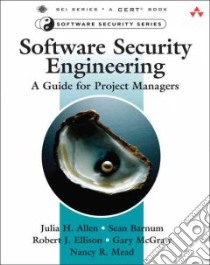- Libreria
- >
- Libri in lingua
- >
Software Security Engineering - 9780321509178
Un libro in lingua di Allen Julia H. Sean Barnum Ellison Robert J. Gary McGraw Mead Nancy R. edito da Prentice Hall, 2008
- € 43.00
- Il prezzo è variabile in funzione del cambio della valuta d’origine
“This book's broad overview can help an organization choose a set of processes, policies, and techniques that are appropriate for its security maturity, risk tolerance, and development style. This book will help you understand how to incorporate practical security techniques into all phases of the development lifecycle.”
—Steve Riley, senior security strategist, Microsoft Corporation
“There are books written on some of the topics addressed in this book, and there are other books on secure systems engineering. Few address the entire life cycle with a comprehensive overview and discussion of emerging trends and topics as well as this one.”
—Ronda Henning, senior scientist-software/security queen, Harris Corporation
Software that is developed from the beginning with security in mind will resist, tolerate, and recover from attacks more effectively than would otherwise be possible. While there may be no silver bullet for security, there are practices that project managers will find beneficial. With this management guide, you can select from a number of sound practices likely to increase the security and dependability of your software, both during its development and subsequently in its operation.
Software Security Engineering draws extensively on the systematic approach developed for the Build Security In (BSI) Web site. Sponsored by the Department of Homeland Security Software Assurance Program, the BSI site offers a host of tools, guidelines, rules, principles, and other resources to help project managers address security issues in every phase of the software development life cycle (SDLC). The book's expert authors, themselves frequent contributors to the BSI site, represent two well-known resources in the security world: the CERT Program at the Software Engineering Institute (SEI) and Cigital, Inc., a consulting firm specializing in software security.
This book will help you understand why
- Software security is about more than just eliminating vulnerabilities and conducting penetration tests
- Network security mechanisms and IT infrastructure security services do not sufficiently protect application software from security risks
- Software security initiatives should follow a risk-management approach to identify priorities and to define what is “good enough”—understanding that software security risks will change throughout the SDLC
- Project managers and software engineers need to learn to think like an attacker in order to address the range of functions that software should not do, and how software can better resist, tolerate, and recover when under attack
Chapter 1: Why Is Security a Software Issue? 1
1.1 Introduction 1
1.2 The Problem 2
1.3 Software Assurance and Software Security 6
1.4 Threats to Software Security 9
1.5 Sources of Software Insecurity 11
1.6 The Benefits of Detecting Software Security Defects Early 13
1.7 Managing Secure Software Development 18
1.8 Summary 23
Chapter 2: What Makes Software Secure? 25
2.1 Introduction 25
2.2 Defining Properties of Secure Software 26
2.3 How to Inf
Informazioni bibliografiche
- Titolo del Libro in lingua: Software Security Engineering
- Autori : Allen Julia H. Sean Barnum Ellison Robert J. Gary McGraw Mead Nancy R.
- Editore: Prentice Hall
- Data di Pubblicazione: 09 Gennaio '08
- Genere: COMPUTERS
- ISBN-10: 032150917X
- EAN-13: 9780321509178


